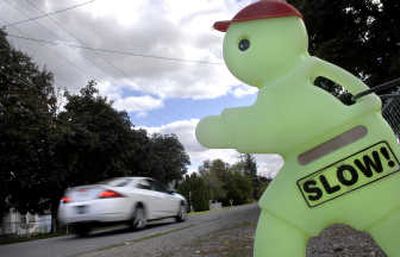Shocking development

Maybe it won’t be tomorrow. Maybe it won’t be next week or even next year, Nicole Gibson said, but a car on Conklin Road will hit someone’s child. A mother living on the edge of this chewed-up ribbon of asphalt will know the pain of being right.
Gibson hopes she isn’t that mother.
“There are two kids over here, three kids over there, two more over there,” Gibson said Monday. She stood on her porch, clutching her miniature Doberman pinscher, while at her side, her daughter, Karlee, ate Oreo ice cream from a blue plastic bowl. Toys were strewn across the lawn of every yard to which Gibson pointed.
Conklin Road isn’t one of those five-lane car-movers punctuated with controlled intersections and overhead halogen lighting. It’s a narrow country street that the suburbs finally caught up to – not so narrow that two Surburbans can’t pass each other, but slender enough to make some drivers nervous.
With a name change on the corner sign, it could be any suburban street in Post Falls, Deer Park or far north Spokane. It just happens to be in Spokane Valley.
Conklin Road also happens to be just south of a new Lowe’s home improvement center and a Kohl’s department store. The big boxes are under construction.
Standing at Gibson’s mailbox, one can see the earthmovers cutting in the entrance to the shopping mecca’s parking lot, to which Conklin Road is a straight shot.
When the stores open in a few months, traffic in front of Gibson’s house is expected to surge to 500 cars during peak hours on Saturdays. That’s a car every seven seconds, assuming the traffic never stops.
But it will stop. City engineers say they expect the stop-sign intersection at Conklin and Broadway Avenue will fail, backing up traffic deep into the neighborhood.
Gibson lives five blocks south of the stores, so she might be spared the traffic jam, but to get home on a busy shopping day, Jason Emmett, who lives less than 200 yards from the Lowe’s parking lot, likely will have to get in line with all the other drivers and slowly inch toward his driveway.
“I didn’t even know what a Kohl’s was,” said Emmett, who has lived on Conklin’s east edge most of his life and has no plans to move.
Most neighbors on Conklin Road don’t have plans to move, though it has been suggested by Spokane Valley Mayor Diana Wilhite that at some point, Conklin could be like nearby Evergreen Road, which was transformed from a residential street to a five-lane semi-commercial strip. Selling out could be profitable, the mayor said when the development was announced.
“It’s always a shock when you have commercial (establishments) move across the street from you,” Wilhite said.
However, the change has been more than a shock. Conklin Road resident Shirley Torgrimson looks at the lots surrounding her home with worry. It seems that everything is in play. It may look like the pastoral setting that drew her to the area in 1972, but it isn’t the same.
People living in the soon-to-be compact suburbs know this feeling, especially if they live on a through street.
The entire city of Spokane Valley has just seven streets that move traffic east-west without a kink or dead end. Nine others move cars north-south.
It has been decades since a new through street was created, which means roads such as Conklin and the people living in the older homes along them take the brunt of traffic from cul-de-sac neighborhoods, with no protection by their city government.
Gibson’s neighbor has taken to stepping into the street to confront speeding drivers, for which the woman has been pelted with garbage and her vehicles have been vandalized.
Emmett occasionally stands in the middle of Conklin at night, waving a child’s neon light saber, the kind made popular by the movie “Star Wars.”
The spectacle doesn’t seem to slow traffic down, Emmett said.
Nothing does.